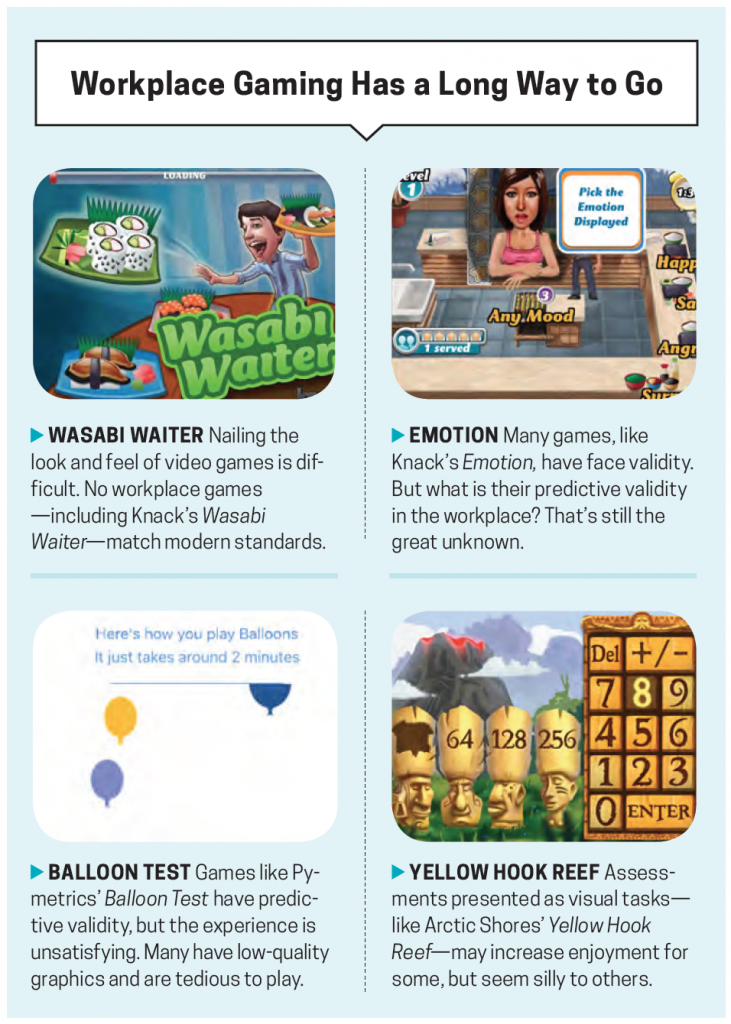More organizations are adopting gamification as a tool to assess talent, but experts wonder whether the fad has the legs to level up.
By Reece Akhtar, Ph.D., Dave Winsborough & Uri Ort
No job in the world provides nonstop intellectual stimulation. Even Elon Musk would tell you that rerouting the future can occasionally be boring. Though most workers trick themselves into thinking otherwise, the truth is engagement and job satisfaction are sinking every year, according to data from Aon Hewitt.
Maybe that’s why we keep pouring resources into approaches that promise to boost employees’ motivation and involvement. The latest bright, shiny fix? Gamification, which takes something that already exists—a process, a training tool, an online community—and integrates game design and mechanics (think points and badges) to motivate participation, adoption, and attainment.
Searches for gamification are skyrocketing, per Google Trends, and the technology research firm Gartner estimates that 40 percent of the largest organizations have already implemented gamification practices. The market is growing at 45 percent a year, and is expected to top $11 billion by 2020.
Gamification isn’t anything new; humans have always played games and responded to incentives. If you’re a member of a frequent flyer program or wear a Fitbit, congratulations: You’ve been gamified! Research on gamers and video games suggests the premise of workplace gamification is very sound, since our biology and psychology respond very favorably to opportunities to solve puzzles and gain status in the form of rewards.
Managing and coordinating virtual “clans” in games such as Destiny, World of Warcraft, and League of Legends requires the ability to cooperate, build teams, lead others, and make effective decisions. Sound familiar? The mental processes needed to win at video games are the same as those that define cognitive ability. And our need for autonomy, mastery, and relatedness predicts both the video games we prefer as well as the kinds of jobs and companies we will thrive in.
There are many examples of organizations using gamification to aid their talent management practices. The U.S. Army uses a first-person shooter game as a recruitment tool; New York–based Pymetrics produced a series of IQ-like games to measure cognitive and behavioral characteristics to aid in candidate-company matching; Delta developed a frontline training game; and Red Bull and Heineken built similar platforms to attract and screen potential job candidates.
Unlike many HR practices du jour, this fad isn’t just sexy—it has a theoretical foundation and growing adoption. But these three issues suggest workplace gamification may not make it to the next level.
Problem 1: There’s No Data
Assessment psychologists pride themselves on having good theory and good data. Best practice requires developing measures that are reliable, predictive of work-related outcomes, and don’t discriminate against protected groups. Very few gamification companies do this; when we quizzed one prominent provider about adverse impact, they said “clients never ask about it.”
Only a very small number of peer-reviewed studies demonstrate that game-based assessments actually predict useful workplace outcomes. Some studies show gamified assessments accurately measure intelligence, but there’s hardly any robust evidence that links game performance with key performance indicators.
Plus, researchers have not studied the adverse impact of these practices, which means it’s possible that built-in bias exists in the games. This can be as subtle as designing games for modern smart phones, but not the old-school phones that some employees still use. These issues raise the chances of a lawsuit and lower the odds of some people being recruited, assessed, or trained well.
In a recent review of the field, Ana Ferreira and Alexandra Araújo, researchers from Portucalense University, say that “without scientific validity, [these tools] are worthless and can produce fake results, with a high impact on [an] organization’s development and sustainability.”

Problem 2: Most Games Are Just Lame
Most current commercial game-based assessments aren’t video games at all—they’re repurposed old psychological lab studies (like the Balloon Analogue Risk Task) or traditional situational judgment tests with a sleeker user interface. Many training games are stilted, poorly animated, and slow.
Despite the obvious flaws, they’re still buckets of fun compared to the antiquated methods. But can these games tap people’s intrinsic motivation like Tetris, or take over their lives like Candy Crush? Fat chance. If nearly half of all employees are dissatisfied with their careers, integrating games as dull as their work won’t accomplish squat.
Practitioners should work with top video game developers to produce solutions as good as recreational games. Until then, as the designer of Diner Dash puts it, gamification is to games as jingles are to music.
Problem 3: Gaming Ain’t Cheap
Rockstar Games spent more than $250 million to make its monster hit, Grand Theft Auto V. We’re not saying talent assessment tools have to cost as much as a shockingly violent game in which you fight prostitutes—we’re definitely not saying that—but gamification development doesn’t come cheap.
A sophisticated product like Wingfinder, which aims to profile tens of thousands of users a month, required two years of planning, design, and programming. Development costs reportedly exceeded $1 million. More modest gamified experiences can be built using pre-developed storylines from Bunchball, Wisetail, or Empower the User, but will still require a substantial investment. And once built, the hosting, maintenance, and upgrades ensure a continued expense.
Don’t underestimate the hidden costs either. Some commentators have labeled gamification “exploitationware” because it promotes loyalty from employees in exchange for meaningless badges or worthless virtual rewards. Employees may feel manipulated, or find the experience childish or trivial. Any firm seeking to implement a gamified system or assessment should undertake significant user testing before plugging in and jumping on the bandwagon.
Just as most people prefer reality to virtual reality, recognize that—as your building a supportive corporate culture for employee development—it’s no time to play games.
Reece Akhtar, Ph.D., is a behavioral scientist and Research Manager for Hogan Assessments. Before pursuing his doctorate at the University College London, he spent two years as a workshop facilitator at Apple.
Dave Winsborough is the founder of Winsborough Limited and the vice president of innovation at Hogan Assessments. An expert on leadership at the top of organizations, he is recognized for his skills in building high-performance senior teams.
Uri Ort is the innovation project manager at Hogan Assessments. Prior to joining the Hogan team, he was the manager of global talent development at S&P Global.


